Breeds | Feeding | Health | Training | Rabbit Proofing | Potty Train
Types of Breeds
Any breed of rabbit can make a good pet. In most cases, there are only two factors to consider when choosing a pet rabbit. The first consideration is the size of the rabbit. The second consideration involves the amount of care the rabbit will need. Larger rabbits are affectionate and docile pets but many need bigger cages, more exercise room, and larger amounts of food. Very large rabbits are difficult to handle and susceptible to health issues. Wool breeds such as the American Fuzzy Lop require a special diet and are ideal pets for expert owners because they need grooming daily. Smaller breeds like the Jersey Wooly are not good pets for young children. Caring for rabbits like these breeds should be left to novice or expert owners.
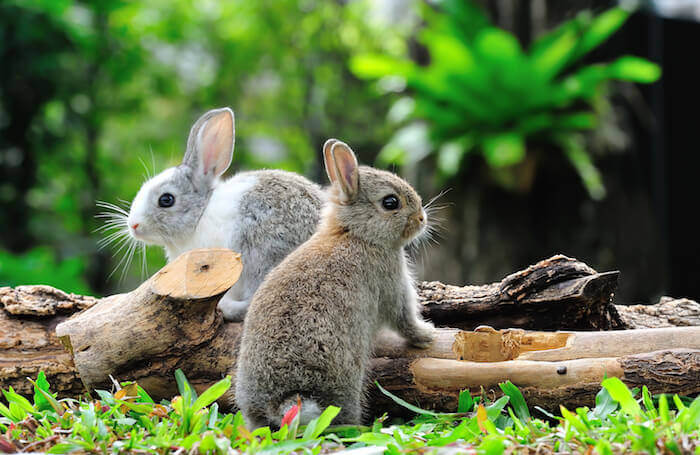
- The Mini Rex is a smaller size pet rabbit that weighs between 3 and 4 lbs
- The Harlequin is breed that is known for it’s calico like coloring. Size and weight can vary.
- The Flemish Giant is the large pet rabbit breed that can weigh up to 15 to22 lbs and 2.5 to 4 feet in length. Darius, holds the record for the largest rabbit at over 4 feet 3 inches in length and 49 lbs in weight.
The English Lop is not recommended for beginner rabbit owners. This rabbit weighs between 9 and 12 pounds. The English Lop has ears that are lopped and extremely large. In some cases, the ears often measure 24 inches from tip to tip. The rabbit’s ears are susceptible to injury and disease which is why this rabbit requires special care.
Further Reading
Buy or Build a Hutch
Temp Control
Behavior & Language
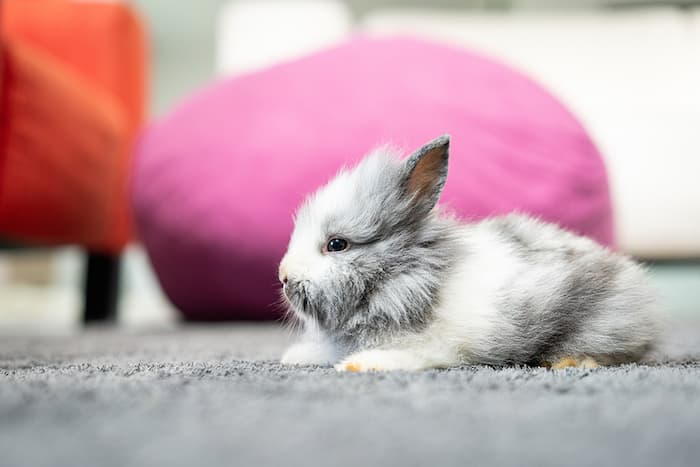
Rabbits for Beginners
The New Zealand rabbit is an excellent pet. This rabbit weighs between 9 and 12 pounds. The body is well-rounded and medium size. This is a rabbit that is commonly used in laboratories.
The Mini Plush Lop is also a great choice for a pet. The rabbit weighs between 2 1/2 and 4 pounds. This breed is a mixture between the Holland Lop, the Mini Rex, and the Mini Lop. The Mini Plush is an affectionate rabbit that makes a good pet for beginner and novice owners.
The Dutch Rabbit is a good pet for children. Taking care of these rabbits would be easier than other types. The rabbit weighs between 3 and 5 1/2 pounds. The ears are large and pointed upright.
Read More
Mini Plush Lop
New Zealand Rabbit
Dutch Rabbits
Food and Diet
There is some confusion about what a rabbit should eat. For the most part, a rabbit’s diet should consist of 75 to 80% hay. More importantly, the hay should be high-quality timothy hay, grass hay, or meadow hay. When a rabbit is in its natural habitat, their diet is high in fiber. This diet consists of mostly grass, leafy plants, and bark. The diet of a domestic rabbit should imitate these eating habits. Hay, fresh vegetables/herbs, and a small number of fiber nuggets are the base of a pet rabbit’s diet. When feeding a pet rabbit, the owner should try to keep the rabbit’s diet consistent. Changing the rabbit’s diet frequently can have a negative effect on their sensitive digestive systems.
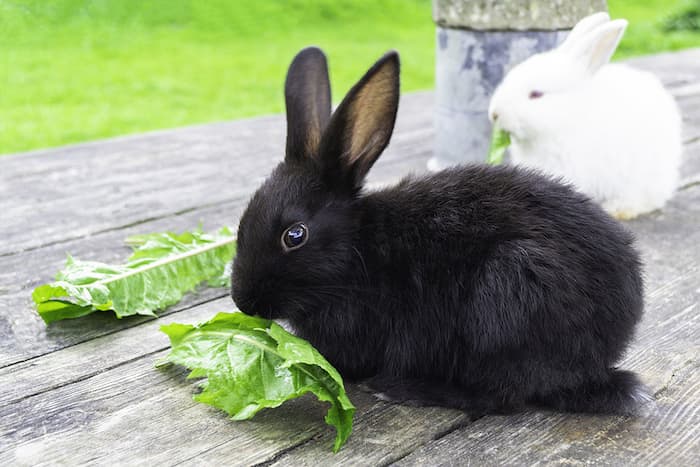
Although many people believe rabbits love lettuce; it is important to remember that feeding a rabbit lettuce can lead to GI stasis. For that reason, never feed your rabbit lettuce. There are many other foods an owner should not feed a rabbit. These foods include items that are high in carbohydrates like cookies, bread, cereal, crackers, chips, and pretzels. Additionally, never feed a rabbit chocolate. In most cases, chocolate is toxic to rabbits.
Hay
Fresh hay should create the bulk of the rabbit’s diet. Hay needs to be available to the rabbit at all times. It is important to remember that younger rabbits eat alfalfa. This is hay that is high in protein and sugar. Alfalfa should never be fed to adult rabbits. It is a good idea to place hay at the end of the litter box. Rabbits tend to poop while eating hay and this will encourage the use of the litter box.
Vegetables
A daily variety of vegetables should be a part of the rabbit’s diet. If feeding vegetables to a rabbit, feed the rabbit fresh and pesticide-free vegetables. When introducing new vegetables into the rabbit’s diet, use small quantities, in the beginning, to judge how the rabbit will react to them. Rabbits typically enjoy broccoli leaves, carrot tops, celery, parsley, and watercress.
Water
Freshwater should always be available in the rabbit’s cage at all times. Hanging a water bottle is a great option. If the rabbit is not drinking enough water; it is a good idea to leave the rabbit’s vegetables reasonably wet.
Pellets
Fresh pellets should be fed to a rabbit sparingly. The best pellets are low in protein and high in fiber. It is important to limit the rabbit’s pellet intake as the rabbit ages. This is primarily because pellets can be high in protein and this can cause health issues and obesity.
Treats
Rabbits should eat treats occasionally. Fruit is usually the best option for a treat, but in small amounts because of the amount of sugar. Fruits that rabbits enjoy include apples, strawberries, pineapples, raspberries, and bananas.
Health
In some cases, rabbit owners attempt to treat rabbits at home for illnesses and injury. However, it is always a good idea to consult a vet when a rabbit is sick or hurt. If the rabbit does not eat for more than 24 hours, has diarrhea for more than 24 hours, or appears physically ill; it is a good idea to visit the vet. The vet can be the difference between life and death for a rabbit. These pets can get sick and die very quickly.
Spaying and neutering a pet rabbit is very important. These procedures have both behavior and health benefits. Neutering a male rabbit helps eliminate the risk of testicular cancer. This procedure can even reduce aggression and eliminate territory-marking behaviors. Spaying a female rabbit can eliminate the high rate of reproductive cancer. As female rabbits get older, they become more susceptible to these types of cancer.
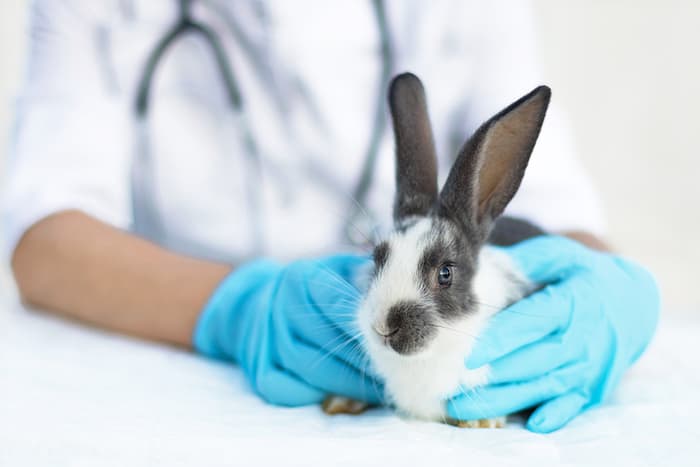
Common Illnesses
- Snuffles are a common respiratory disease in rabbits that causes discharge from the ears, nose, and eyes. This disease also causes severe sneezing. Treatments include a number of antibiotics, but a cure has not been created. The best treatment for Snuffles is prevention. Firm sanitation and good ventilation also help to prevent this disease.
- Sore-Hocks are a genetic issue that is easily diagnosed by open wounds on a rabbit’s footpads. This issue is caused by footpads lacking fur and uncut toenails. These sores can lead to secondary infections and cause the rabbit to sit in the corner and remain inactive. The best treatment is Preparation H. Applying this cream to the rabbit’s footpads will help heal the sores. It is important to keep the area clean or it can become infected.
- Ear mites are caused by parasites that like to make a home in a rabbit’s ear canal. The mites irritate the rabbit daily, which causes scratching that can lead to infection. Symptoms include brown wax, shaking the head, and scratching the ears. The treatment requires placing drops of oil in the rabbit’s ears and massaging the base. The oil will eventually drown the mites. The illness should be treated up to three times a day, for three days. These steps should be repeated in ten days to eliminate hatchlings.
Training
When picking up or holding a rabbit, it is important to never pick the rabbit up by the ears, the tail, scruff, or the legs. This can be painful for the rabbit and cause severe damage. More importantly, owners should be gentle and remember that rabbits are fragile and have weak skeletal systems. In most cases, rabbits do not like being picked up. Some rabbits may tolerate being picked up, but many struggle when owners attempt to lift them. Some rabbits may even be okay with being on leash.
- Approaching the rabbit slowly and pick it by getting down to the rabbit’s level.
- When lifting, scoop the rabbit up by putting one hand under the torso and holding the rabbit close to the body.
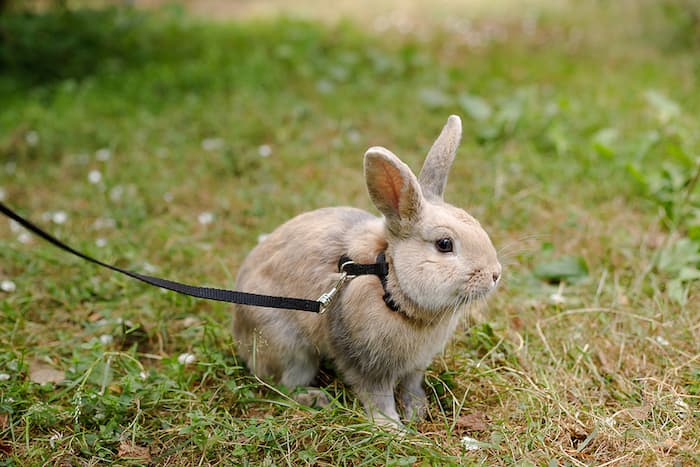
Rabbit Proofing
Bunny proofing the home can help protect the rabbit as well as the home. A rabbit’s nature is to dig and chew, but these habits should be conducted in a non-destructive manner. Providing toys to the rabbit can help discourage the rabbit from chewing on household items. However, supervision is the best way to prevent destructive chewing.
In most homes, wires are one of the primary targets of rabbits. The sharp teeth slice through wires rather easily and can damage household items or electrocute the rabbit. It is a good idea to cover wires with flex tubing and plastic sleeves.
Rabbits are also very good at squeezing into tight spaces. It is important to block areas and paths to places like under the bed or behind a bookshelf. In most cases, puppy-pens or baby fences are effective. However, these items should be created using metal, otherwise, the rabbit will chew through it rather quickly.
Houseplants are a health hazard to rabbits. These types of plants are toxic to rabbits. It is best to remove these plants entirely or place them out of reach of the rabbit. Bunny proofing the home can offer a safe environment for the rabbit and prevent damage to the home.
Potty Training
Potty training a rabbit is not an easy task. Give the rabbit a small litter box with no top and low sides. For litter, use recycled newspaper or unscented kitty litter. Never use clumping litter or clay-based litter. This type of litter can be harmful to a rabbit’s respiratory system.
The easiest way to create good litter box habits is to limit the rabbit’s space at first to only the litter box or cage. The rabbit will consistently begin to use the litter box and then the owner can slowly expand the space. If the rabbit starts to forget to use the litter box, then place a limit on the rabbit’s space until acceptable habits resume.
Litter training takes time and patience. In most instances, when rabbits are about to go outside the litter box, try to pick them up and place them in the litter box. This will help to keep them trained.
Reviewed By: Tim Winter

Tim Winter has a strong affection for pets and wildlife. His years of experience caring for various types of pets has led him to share his knowledge with others on the best practices in pet care. Tim holds a Bachelor of Science from the University of Oregon School of Journalism and Communications.
More About Rabbits
Can a Rabbit Serve as an Emotional Support Animal?
Emotional support animals (ESAs) have witnessed a surge in popularity, offering invaluable emotional comfort and companionship to those grappling with mental health issues. While dogs and cats are the most conventional choices as ESAs, have you ever considered whether a rabbit can fulfill this role? In this blog post, we will explore the feasibility of ... Read more
A Starter Guide to Taking Care of a Rabbit
Did you know that rabbits are one of the most popular pet choices in the world? These social and smart animals make wonderful companions for many families and children. If you are new to rabbit ownership or are thinking about adding one to your existing family, you need to know how to care for your ... Read more
Important Things You Should Consider Before Getting A Rabbit
Rabbits may seem like a low-maintenance pet that can fit perfectly into any home, but there’s more to think about than just how cute they look. Before bringing a rabbit into your family, it is important to understand what goes into caring for them and whether or not you are adequately prepared for the task ... Read more
Looking After Your Pet Rabbit in the Springtime
Rabbits are a fantastic first pet for children, and a great addition to any family unit to boot. Though they are small, and even their hutch can take up a small footprint in your home, they nonetheless require diligent care in order to stay happy and healthy. Springtime is no different, and in fact, presents ... Read more

I never really knew about these pets, But i thought there were quite a few of pros and cons about rabbits. So maybe in about 3 or 4 years maybe we will think about having a pet Rabbit.
I’m getting a rabbit soon, so does anyone have any tips on how to read the bunnies body language???
I Have 2 dwarf baby bunnies,thought they were both girls but turns out 1 is a boy,they have started humping and i an worried the female is pregant .they are 4 months old.Are there any signs to let me know if this is so.I have now split them up.
well if it were me I would get both rabbits neutered, that way they are able to play and together and there will be no chance of rabbit babies. the male rabbit will become fertile around 6 months of age so you should be good for now but I suggest getting them fixed asap. most vets wont do rabbits but if you go to a exotic animal vet you should be good. i hope this helps
Don’t worry! I’m a bunny breeder and bunnies are actually very easy to care for as long as you get the right breed for you. I recommend Dutch rabbits and Netherland dwarfs. PS: baby bunnies are adorable! My bunnies gave birth recently
Potty training is my biggest concern, Does anybody have any tips about potty training Rabbits?
I never really knew about these pets, But i thought there were quite a few of pros and cons about rabbits. So maybe in about 3 or 4 years maybe we will think about having a pet Rabbit.